3. The Golden State
Every state has an official nickname. California’s is “The Golden State.” So even though Disney’s California Adventure’s Hollywood Pictures Backlot is a celebration of “The Golden State,” the Golden State district within the park is a separate area. Or maybe more to the point, it’s many separate areas…
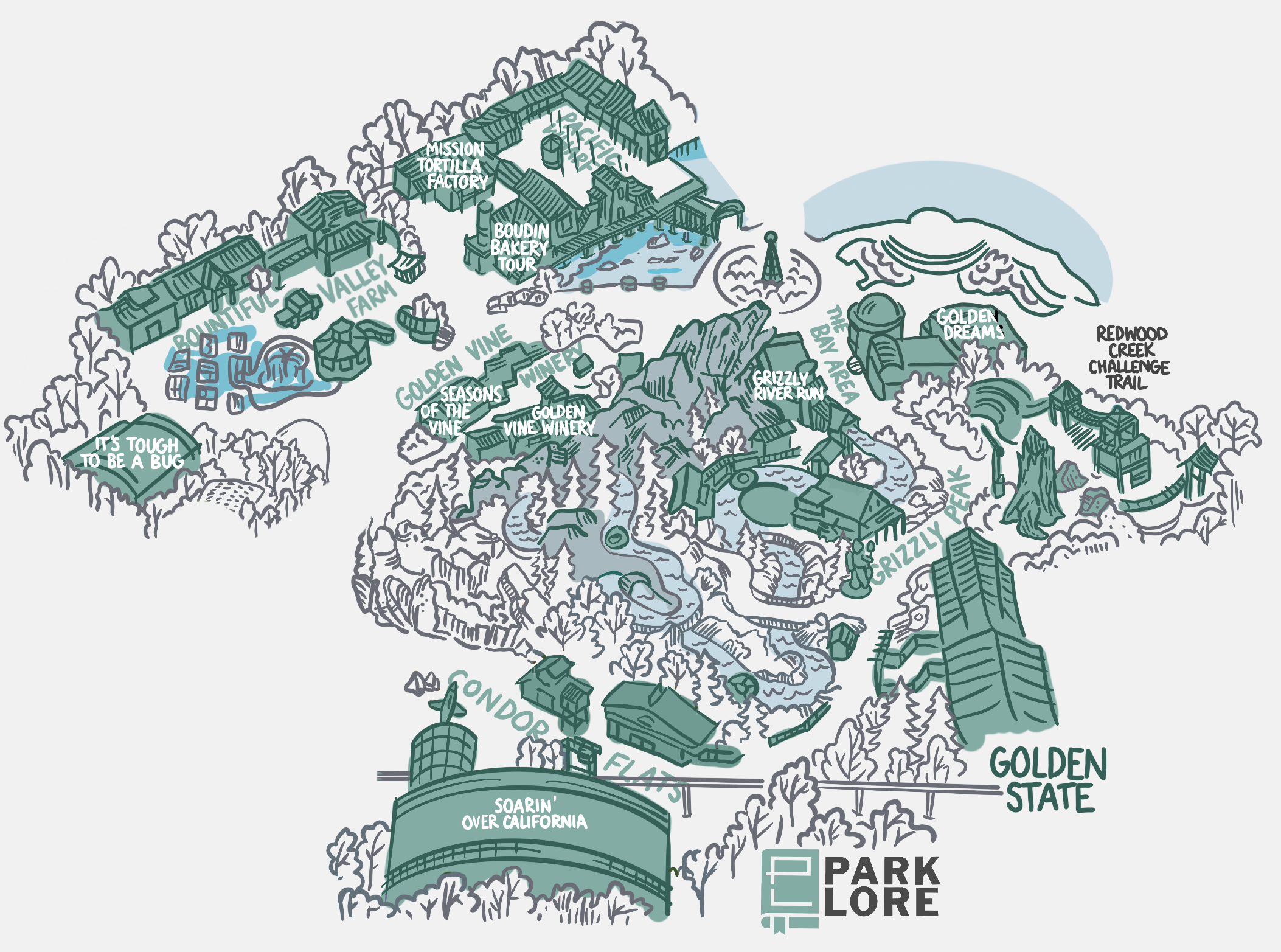
Actually, the Golden State at Disney’s California Adventure is one district that’s officially sub-divided into six smaller areas – each meant as a sort of symbolic nod to the vast and diverse environments that reside within the state. So even though the Golden State is the largest district in Disney’s California Adventure by area, our tour of it is a whirlwind one made of individual “sub-districts” of differing setting and style…
1. Condor Flats

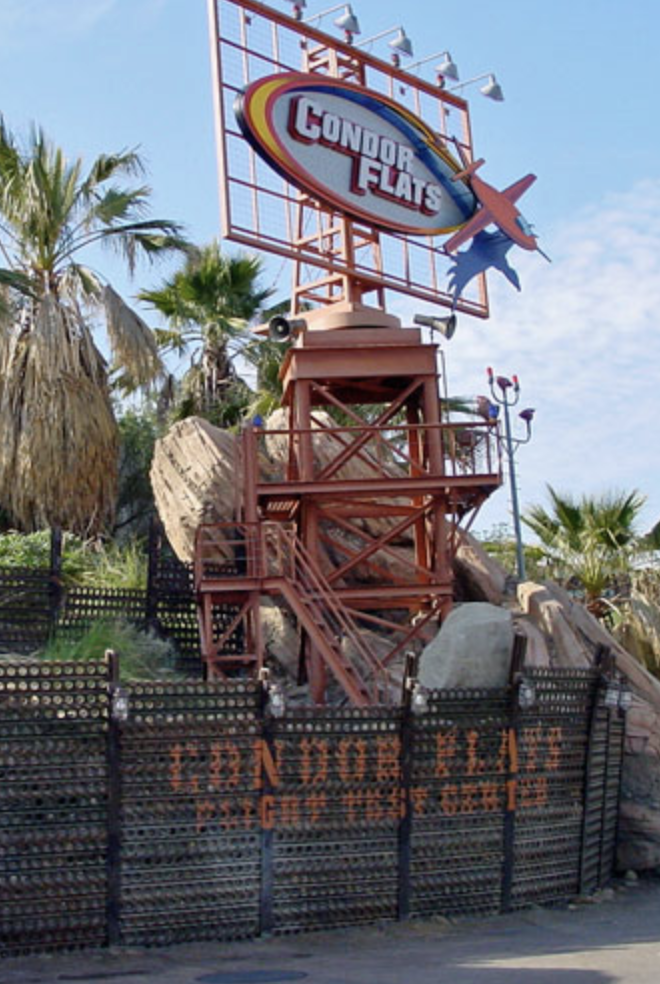
Traveling counter-clockwise around the Golden State from Sunshine Plaza, the first “sub-district” guests encounter is Condor Flats. This elongated plaza is meant to evoke the setting of a remote Southern Californian desert airfield. It’s industrial and militaristic, with steel plates holding back “falling rocks” from desert elements; rotating radar dishes; iron scaffolds. Most of the land is made of a palm-lined “runway” open to foot traffic.
Actually, Imagineers invented an elaborate backstory for Condor Flats – that this remote, arid airfield was once a hotbed of California’s burgeoning aviation industry. Here, pilots risked life and limb to test out new aircraft designs – from propellor planes to supersonic jets and onward to space shuttles.
Unfortunately, the story goes, the drawdown of investment in aeronautics in the 1960s hit Condor Flats hard, leaving the few remaining pilots to turn this past-its-prime runway into the home of Condor Flats Air Tours – a tourist-ready ode to the past, present, and future of aviation in California.
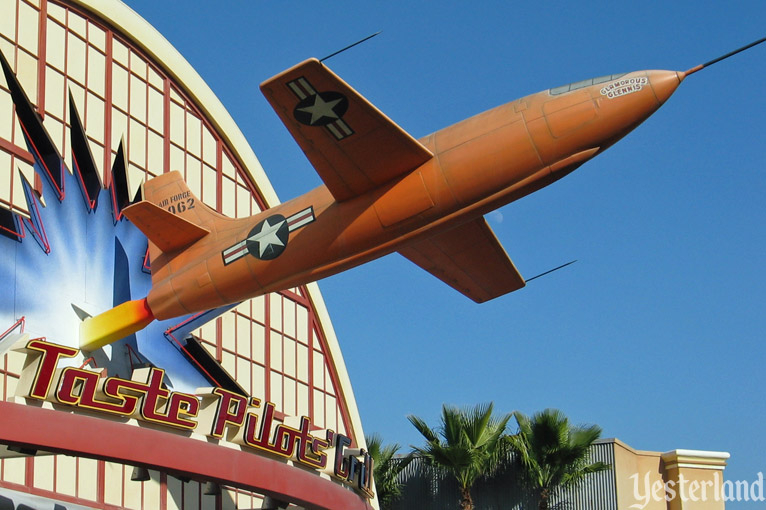
Around Condor Flats, you can see evidence of how remaining entrepreneurial aviators turned old hangars into tourist-ready retail spaces (like the “Fly ‘n’ Buy”) and dining spaces (like the “Taste Pilots Grill” – “Where Great Food Is Rocket Science,” complete with a comical interpretation of the Bell X-1 that pilot Chuck Yeager used to break the sound barrier back in 1947 bursting through the facade). At Disneyland, a land themed to California aviation might’ve been set then, in the heyday of mankind’s quest for the skies. But at California Adventure, that day was a long, long time ago.
After Superstar Limo back in Hollywood Pictures Backlot, Condor Flats at least brings us California Adventure’s second ride.
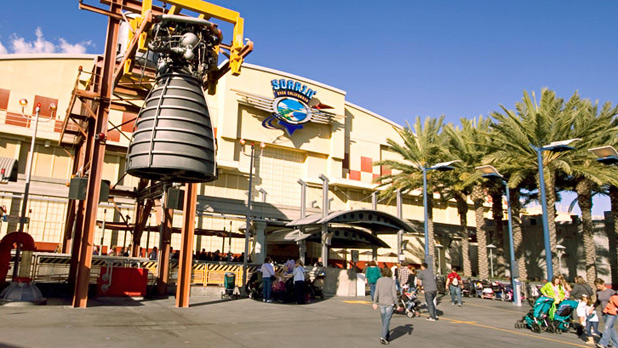
Housed in a weather-worn, dust-colored airplane hangar off the asphalt runway resides the Lost Legend: Soarin’ Over California. Although there’s an official backstory here, too (about how Condor Flats’ young aviators have invented a new mechanism to simulate flight), Soarin’ is stronger without it. It’s best to just let the ride speak for itself.
Suspended in unique hang-glider seats, Soarin’ Over California ingeniously hoisted guests high up into a curved, all-encompassing OMNIMAX screen, sending them gliding across the inspiring landscapes of the Golden State in time with a (pun intended) soaring musical score. Majestic, moving, and thoughtful, Soarin’ wasn’t just the anchor attraction of Condor Flats and the larger Golden State; it was arguably the only genuine E-Ticket centerpiece of “DCA 1.0,” and surely the most ambitious ride at the park. (It would, of course, be duplicated at EPCOT, Shanghai Disneyland, and Tokyo DisneySea in time.)
Despite its E-Ticket ride, Condor Flats never quite accomplished its aim of feeling like an expansive desert airbase. With the forested slopes of Grizzly Peak to the south, the massive Soarin’ hangar to the north, and the multi-story Grand Californian Hotel up ahead, the area couldn’t really sell the “illusion” of being a remote desert airfield.
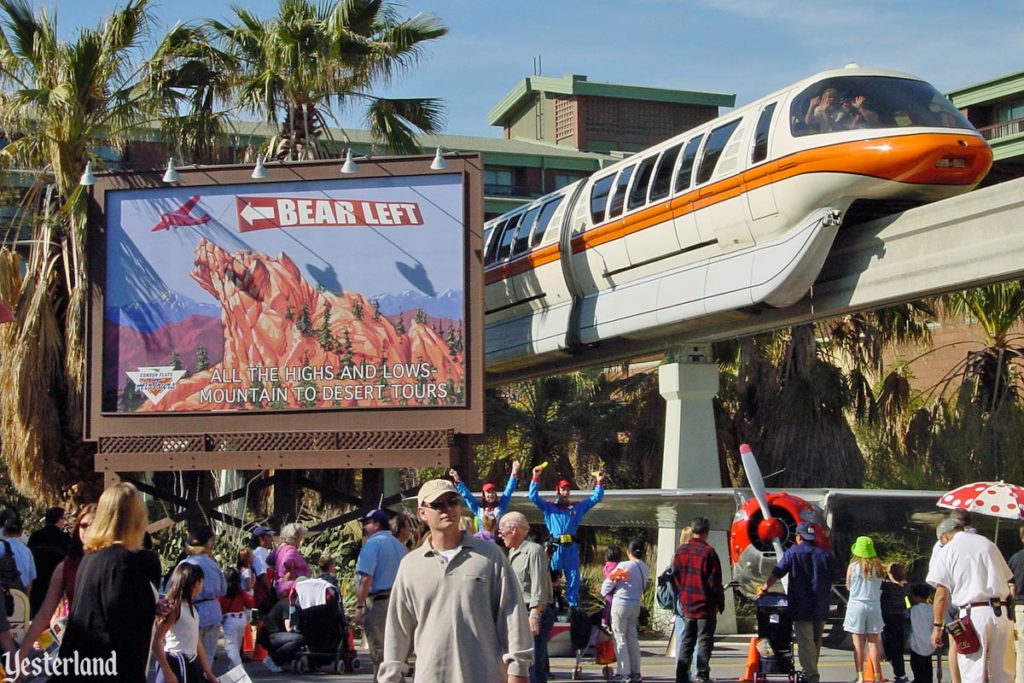
But as with every problematic element of “DCA 1.0” we’ve seen so far, Condor Flats’ real issue was foundational; quite simply, it lacked the “magic” that Disneyland visitors expect will transport them to long-forgotten, fantasy-infused places and times. With its industrial scaffolds, rusted space shuttles parts, iron catwalks, and beige hangars all with the Grand Californian Hotel looming beyond and the Monorail gliding through, Condor Flats insisted on anchoring you in a modern Disney park’s interpretation of a modern place in California.
And following the billboard to “Bear Left” at the runway’s end leads into the next “sub-district” of the Golden State, and one hampered by the same avoidance of fantasy…
2. Grizzly Peak Recreation Area
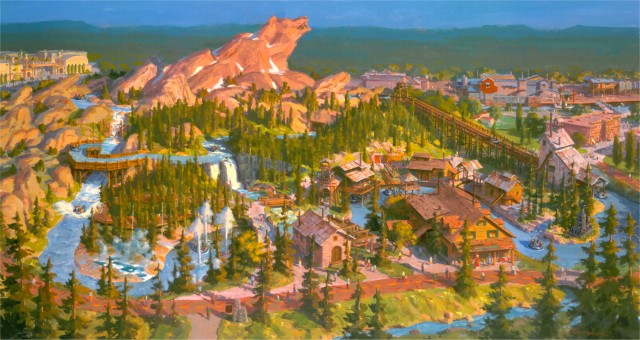
On paper, Grizzly Peak Recreation Area might’ve been most clearly understood as California Adventure’s equivalent of Adventureland, here incarnate as an invented State Forest or National Park resembling in combination elements of Redwood Forest, Yosemite, and the High Sierras. A land of forest trails, evergreens, geysers, misty rivers, log cabins, and old mills, Grizzly Peak (built around the eponymous mountain and de facto icon of the young park) was clearly the richest and most textured of California Adventure’s opening day environments.
Not coincidentally, it was also among the most self-contained. The winding stretch of the park’s “midway” that it entailed was sheltered by Grizzly Peak and its forests on one side, and by the Grand Californian Hotel (working “in-universe” as the park’s lodge) on the other – one of the few areas within the infamously berm-free park where visual intrusions and peeks of the modern world were truly rare.
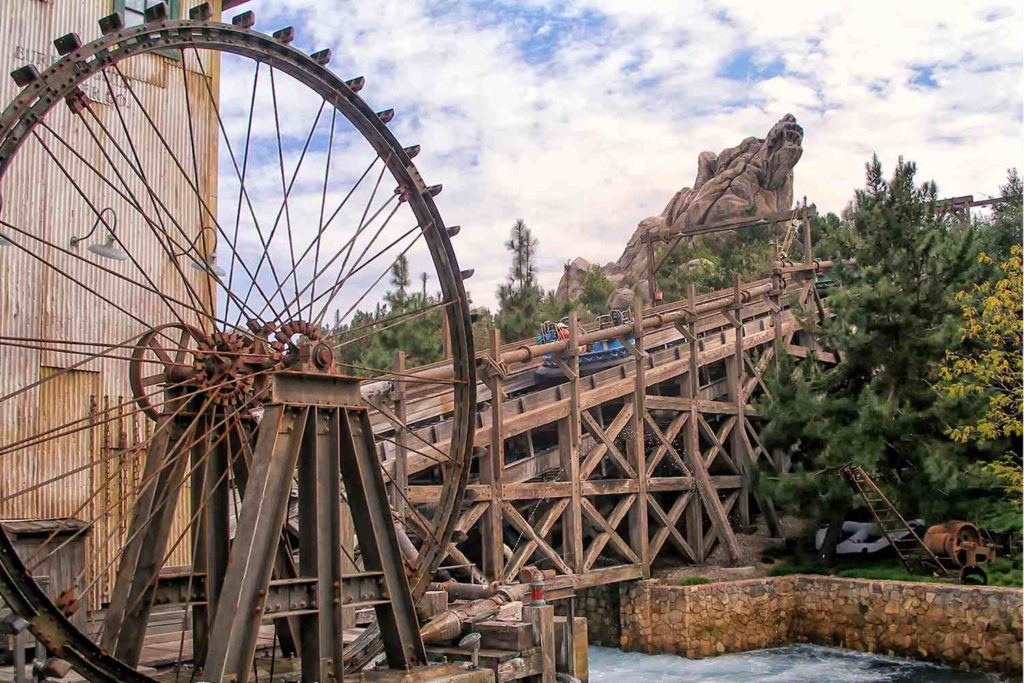
But given the park’s “DCA 1.0” mindset, Grizzly Peak simply couldn’t help itself. Rather than following Imagineering precedent that no doubt would’ve set the land in the 1950s – the heyday of the American road trip – Grizzly Peak was set (you guessed it) now. Designers went to great lengths to visually communicate to us that this is not a beautiful, historic National Park at its prime, but instead an old, worn, rusted State Park “Recreation Area” that has “mercifully” been overtaken by extreme sports aficionados – part of yet another extraordinarily expositional backstory for a park “sub-district.”
Suffice it to say that thanks to the entrepreneurial Grizzly River Rafting Company, the natural waterways around Grizzly Peak would gain some life by way of Grizzly River Run – a white-water rafting expedition weaving through old, rusted, weather-worn remnants of a long-ago timber operation.
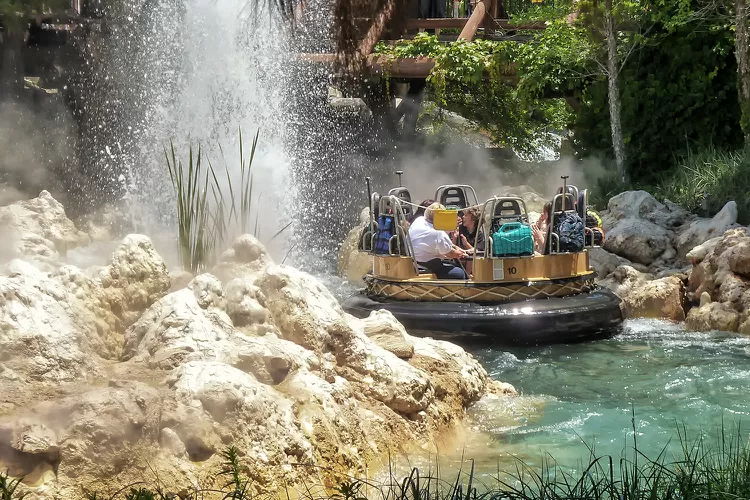
In our park-wide tour, Grizzly River Run would be the third ride we’ve encountered (after Superstar Limo and Soarin’ Over California). On paper, Disney would probably call it a second E-Ticket… But even if the sock-drenching raft ride does pass through some spectacular environments in and around the 110-foot tall mountain, it’s oddly lifeless. Along the way, guests pass through a cave where they hear bears, but there are no animatronics or even static figures of Californian wildlife along the ride’s course…
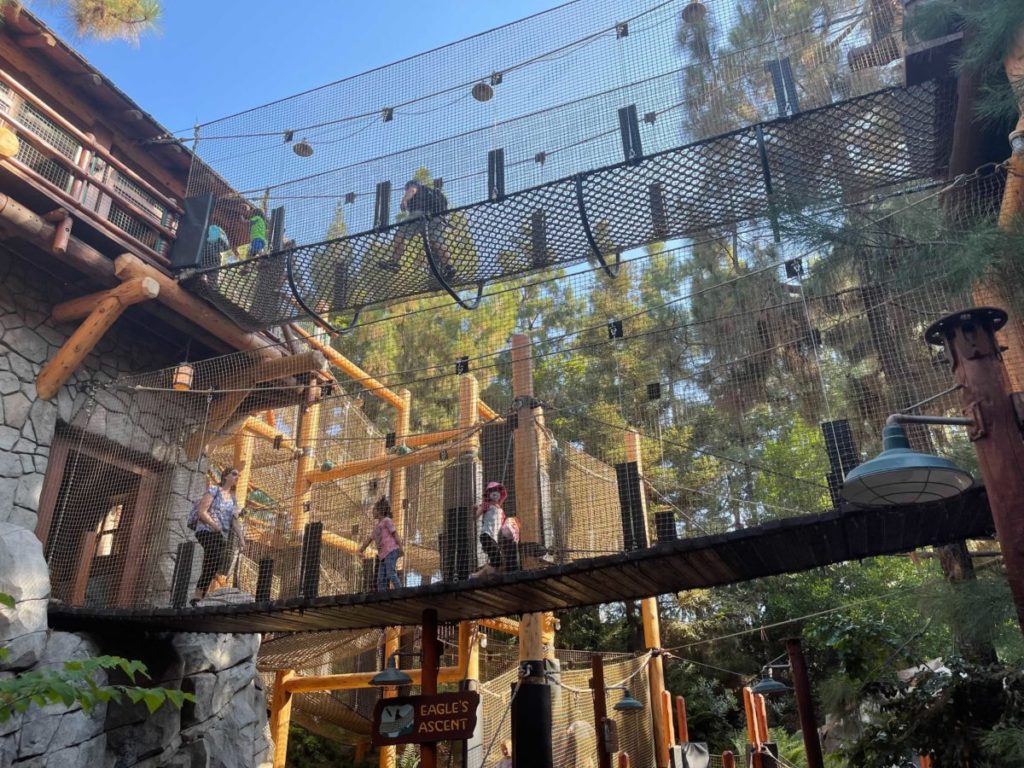
Grizzly Peak’s other offering is the Redwood Creek Challenge Trail. Again among the few outright successes of the park in 2001, it’s something of a Tom Sawyer Island equivalent, allowing families to scurry up nets, slide down zip lines, hop over creeks, gather around for a Scout-style storytelling ceremony, climb fire watchtowers, and participate in self-guided “nature center” style activities as they explore.
Obviously, Grizzly Peak Recreation Area is a beautiful land. It makes it all the more a shame that – like the rest of the park – it fights so hard against the natural, Disney inclination to take us somewhere that can only exist in our imaginations; somewhere idealized and perfected and lovingly restored.
3. The Bay Area
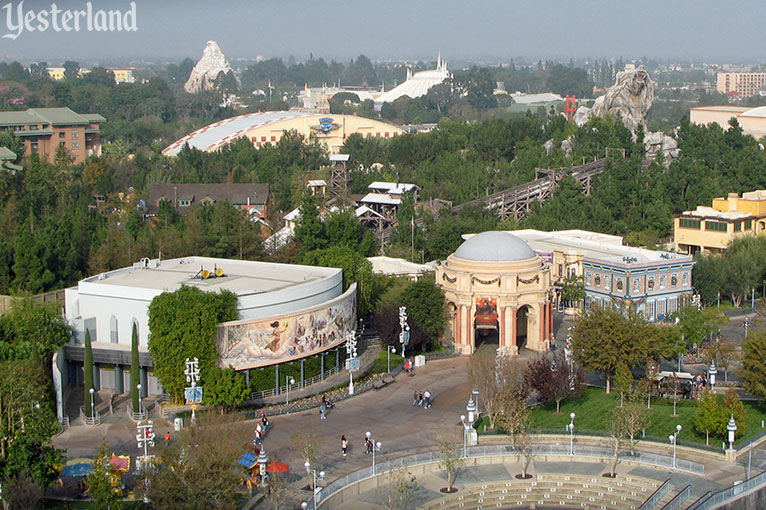
The dense forests of Grizzly Peak drop guests off in a corridor comprised of a block of San Francisco row houses on the left, and a scaled recreation of San Francisco’s Palace of Fine Arts – an ornate, domed landmark of the 1915 Panama-Pacific Exposition – on the right.
The row houses are curiously empty but for a set of restrooms. The Palace of Fine Arts, however, serves as the entrance to this “sub-district’s” single attraction – a 70-mm film called “Golden Dreams.”
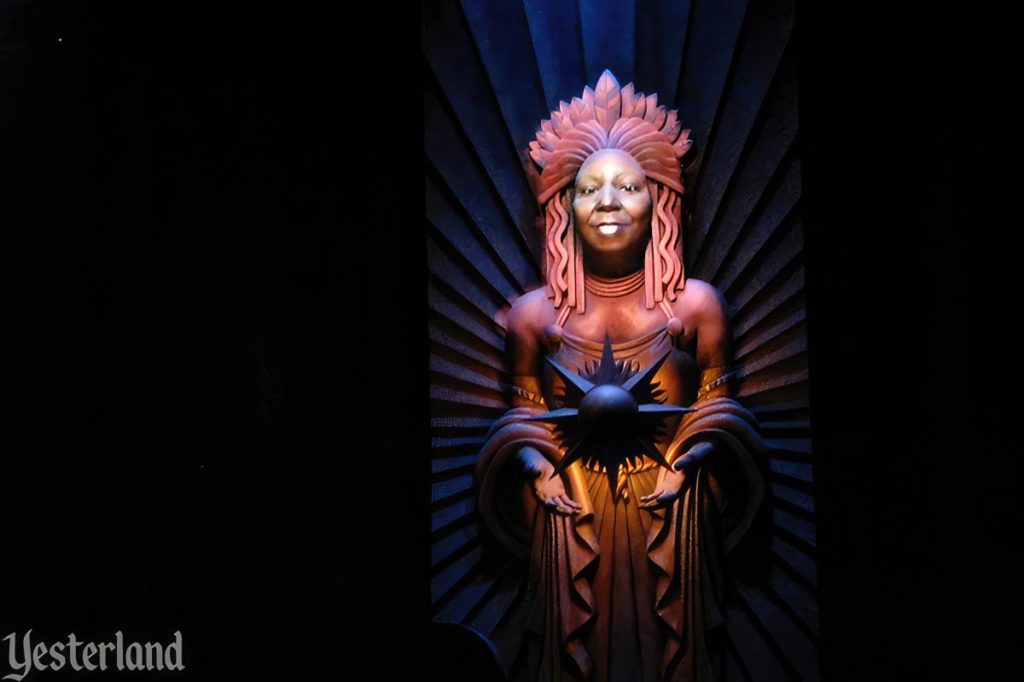
Inside the 350-seat theater, art deco statues flanking either side of the projection screen depict Queen Califia from Garci Rodríguez de Montalvo’s 15th century adventure novel Las Sergas de Esplandián – the fictional character after whom California was named. Through rear-projection, Califia (played by Whoopi Goldberg in her second in-park appearance after Superstar Limo) would awaken and narrate the film.
A sort of creative, 22-minute retelling of the story of California, “Golden Dreams” was something of an analogue to EPCOT Center’s educational films, touching on the spirits of progress, immigration, agriculture, exploration, entertainment, and technology that’s drawn people to the Golden State for centuries.
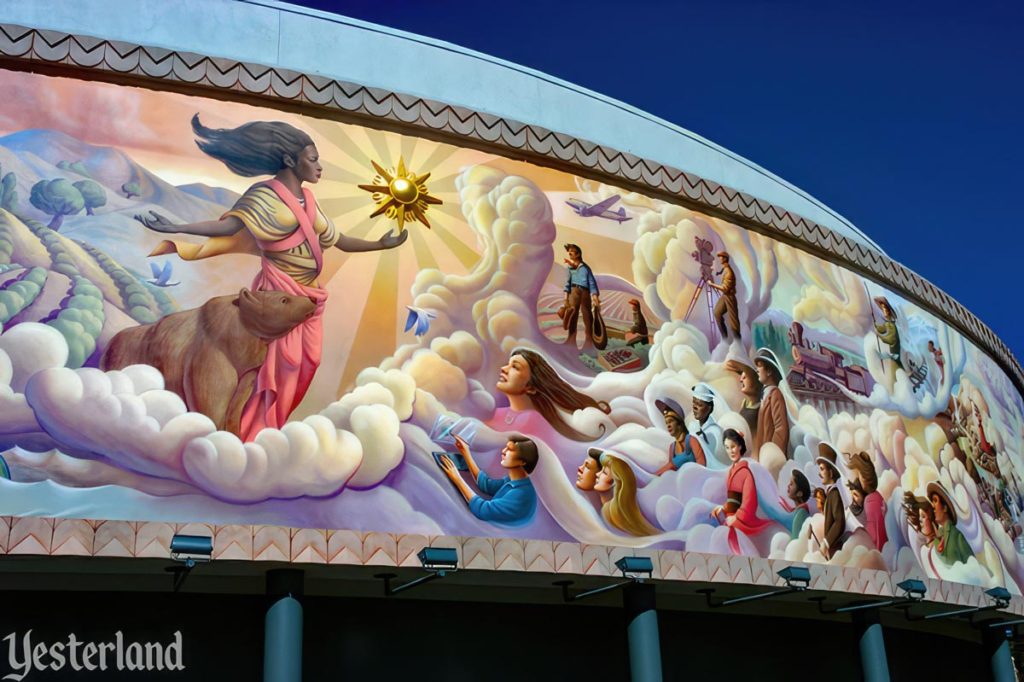
Outside of the theater, a curving mural wrapped around the theater’s oblong shape depicts Califia with her golden light serving as a beacon to immigrants, artists, adventurers, and industrialists, drawing them to the West Coast. That mural looks out across the park’s Paradise Bay, where “The Bay Area” includes a descending amphitheater to the water’s edge. (It’s just for relaxing; aside from a temporary holiday show piloted during the park’s first year, Paradise Bay isn’t set up to host a nighttime spectacular.)
All in all, “The Bay Area” feels like a strange sub-district looking for a reason to exist. Maybe designers acknowledged that San Francisco needs represented in a park dedicated to California, but didn’t have the space or time to create a real tribute to the city; especially with the Golden Gate Bridge already absconded to Sunshine Plaza. In any case, The Bay Area may have an “attraction,” but it doesn’t contain any rides. And that trend will continue in the rest of the Golden State…
4, 5, and 6. The Rest of the Golden State

By navigating the continuous pathway around the north side of Grizzly Peak, we’ve passed through three “sub-districts” of the Golden State – Condor Flats, Grizzly Peak Recreation Area, and The Bay Area. Three further “sub-districts” reside along the south face of Grizzly Peak, but it’s easy enough to breeze through them (literally and metaphorically) because the “rest” of the Golden State contains no rides at all.
Pacific Wharf
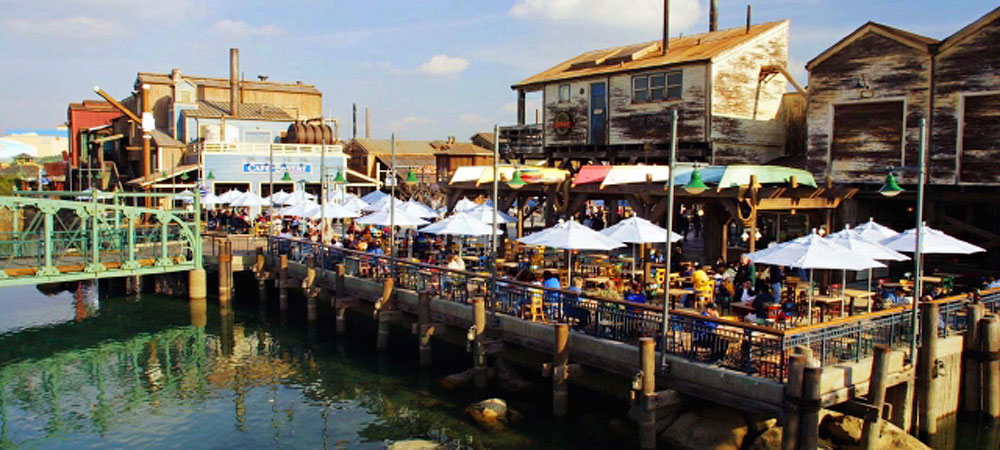
Continuing our counter-clockwise march around the central mountain, we’d next encounter PACIFIC WHARF. It’s actually an attractive area of the park. Continuing the waterfront real estate of The Bay Area, Pacific Wharf was meant to recreate the fisheries and factories of Monterey and San Francisco. The “sub-district” surely benefitted from having nooks and crannies to explore, but its primary purpose was to serve as a central food court for the park, with eateries like the Lucky Fortune Cookery, Cocina Cucamonga Mexican Grill, and the Pacific Wharf Café.
The land also contained two “attractions” – the Boudin Bakery Tour (sponsored by the San Francisco-based bakery founded in 1849) and the Mission Tortilla Factory (sponsored by Mission Foods, which was founded as a California-based subsidiary of the Mexican Grupo Maseca corporation in 1977).
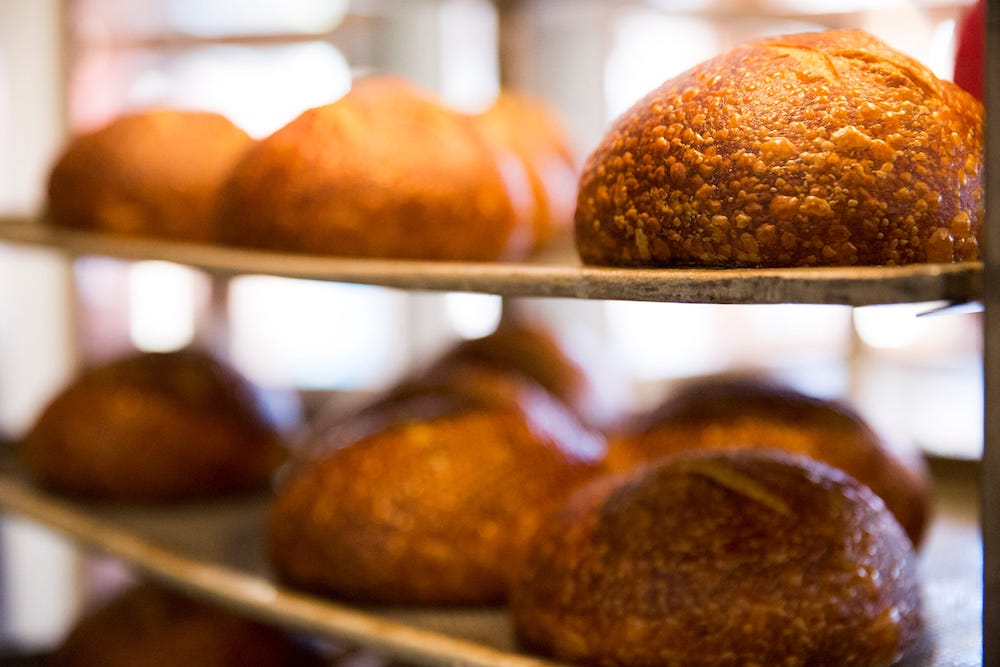
Both are embedded partnerships wherein guests view the machines, ingredients, and manufacturing process behind the creation of Boudin’s sourdough bread and Mission’s flour tortillas, taste a sample right off the assembly line, and then (Disney would hope) delight in the final product by way of a soup bread bowl or burrito back in Pacific Wharf. (Of course, in keeping with “DCA 1.0’s” ethos, the former was “narrated” via television monitors by two Disney-adjacent “stars” of the era – Rosie O’Donnell and Colin Mochre of Whose Line Is It Anyway?.)
The Golden Vine Winery
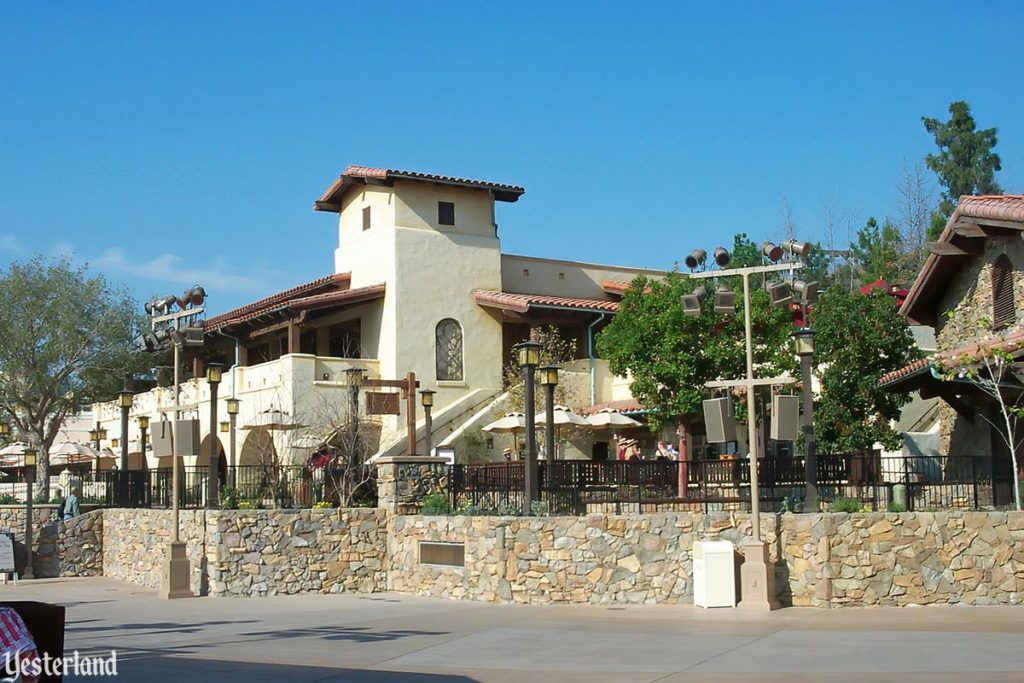
The fifth “sub-district” of the Golden State is the Golden Vine Winery – a terraced complex of eateries nestled into the wooded south face of Grizzly Peak. The entire complex is sponsored by well-known winemaker Robert Mondavi, and contains not just the upscale Vineyard Room restaurant (on the second floor) but the grab-and-go mixed-retail space Wine Country Market (on the ground floor).
The area’s only “attraction” is “Seasons of the Vine: A Window Onto Wine Country” – a seven-minute short film shown in the intimate “Barrel Room” wine cellar, where Mondavi Wine tasting was also offered. In a park themed to California – and one that aspires to focus on fine dining and retail a la EPCOT – it probably makes sense to dedicate an entire sub-district of The Golden State to Napa Valley and wineries… but it did feel a little glib.
Bountiful Valley Farm
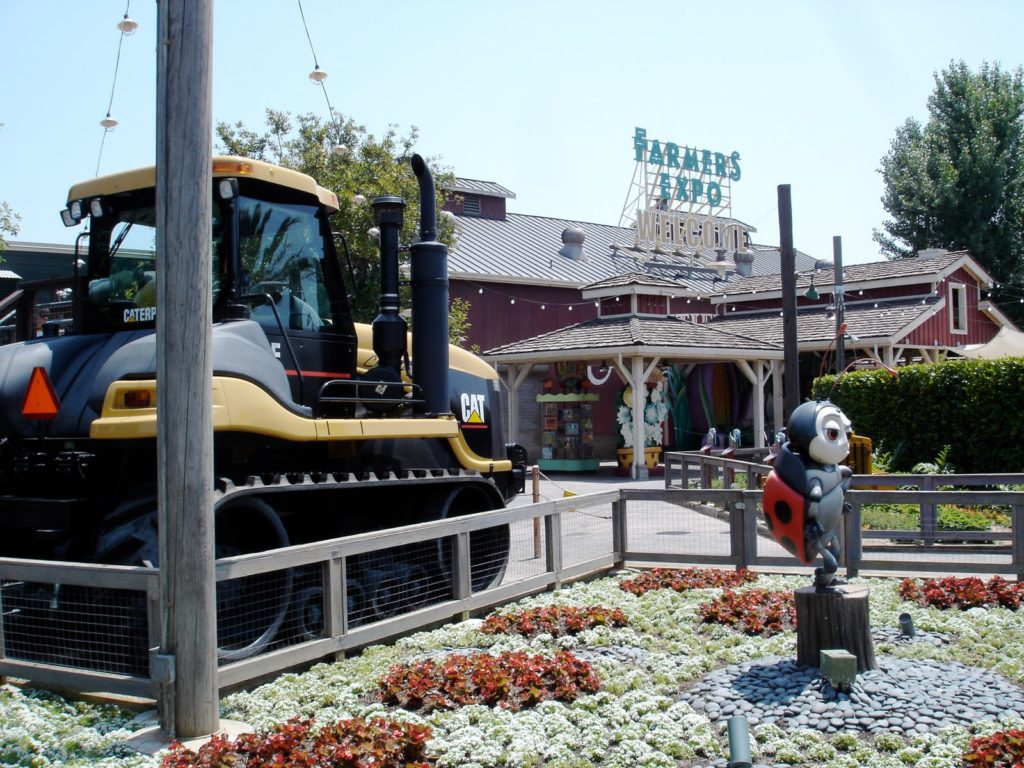
The “dream of agricultural bounty” had been one of the central “dreams” of California Adventure from the park’s very first shaping sessions, and that dream is incarnate in the sixth and final “sub-district” of the Golden State, Bountiful Valley Farm.
It makes sense… California’s Central Valley alone – along State Route 99, from Bakersfield through Fresno, Modesto, Sacramento, and on toward Redding – effectively produces all of the almonds, pistachios, pomegranates, and walnuts eaten in America. But that’s just the start. Altogether, California is number one out of all fifty states when it comes to agricultural output, with the Golden State growing about half of all produce and a quarter of all food in the nation.
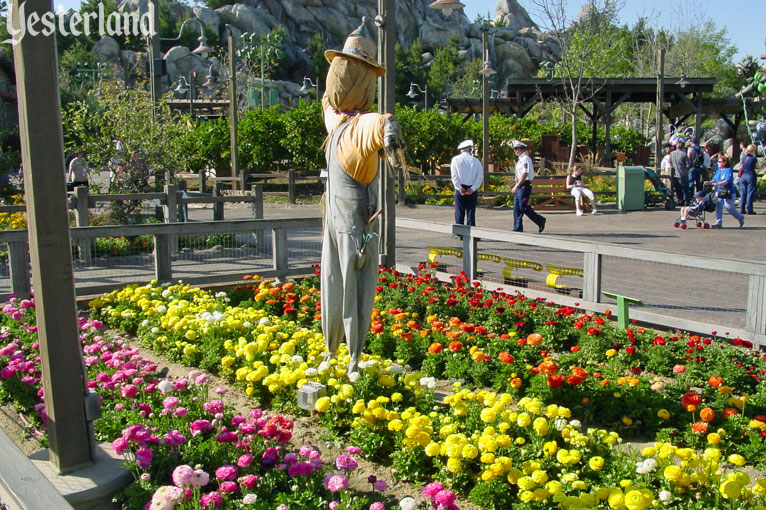
Anyway, as expertly recollected in Yesterland’s entry on the area, the Bountiful Valley Farm is basically a walkthrough exhibition that includes notes of EPCOT’s Flower & Garden Festival, a quick service eatery, and plenty of big, bright, yellow Caterpillar tractors – owing to the company’s sponsorship of the area.
Milling among farm buildings and fenced-off planter plots, you might encounter neat flower beds, rows of Californian crops, informational placards regarding farming tools, an irrigation-themed splash pad and water play area, and small barn-roofed stage. The park guide map even counts a Caterpillar tractor whose cab you can climb into as one of the park’s 22 attractions, which… sure!
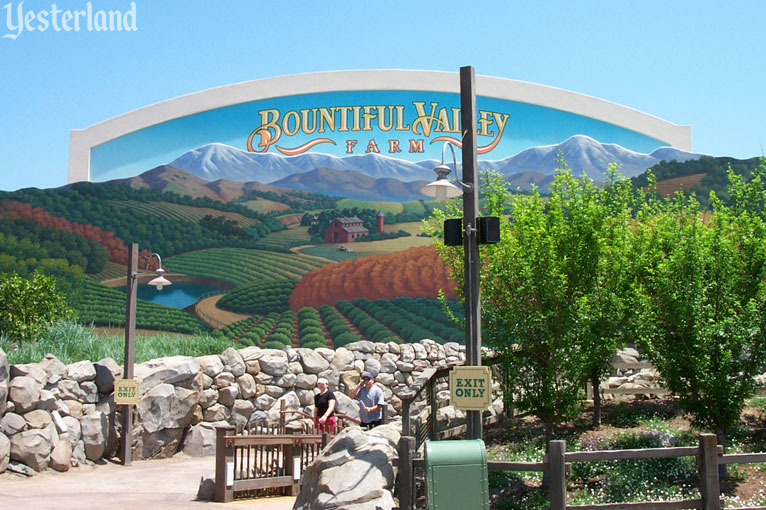
More to the point, Bountiful Valley Farm does include a sizable attraction: “It’s Tough to be a Bug,” the 3D film imported from Disney’s Animal Kingdom. (Here, rather than being hidden in a giant tree, the theater is quite visible, “disguised” only behind a multi-tiered, postcard-style farm mural, above, and accessed via an “Ant Hill” queue that diverts guests underground.)
Bountiful Valley Farm wasn’t a bad area by any means… but it wasn’t what people expected from a Disney Park. Maybe farming was inherently an inappropriate focus for an entirely area at a theme park – even one opting for “edutainment” over rides. In any case, “cheap and cheerful,” Bountiful Valley Farm was an ode to agriculture that you might expect from a well-appointed state fair or a local amusement park, not Disneyland. Especially joining Pacific Wharf, Golden Vine Winery, and The Bay Area as regional “samplers” with neither any significant rides nor especially compelling environments, Bountiful Valley Farm came across as yet another disappointingly low-budget project.
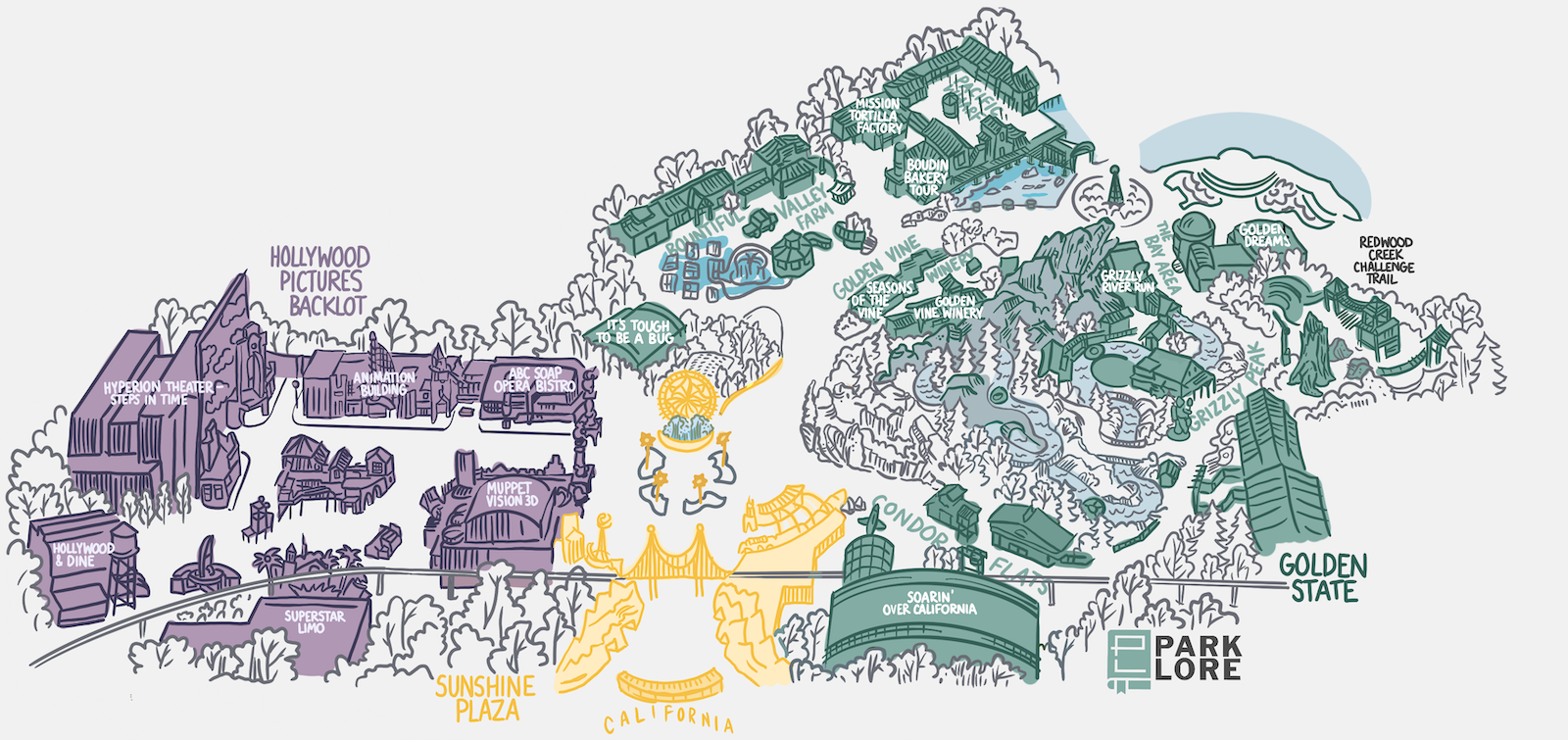
The Golden State was far and away the largest district in the park, and probably did contain the most to see. However, it was largely fluff. For those counting, in terms of actual rides, we have only Superstar Limo, Grizzly River Run, and Soarin’ Over California. Three rides total among the park’s first three lands. That’s because most of the park’s rides are contained in the final land…

